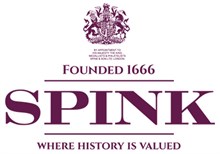Anglo-Saxon, Kent, Eadbald (616-640), Thrymsa or Shilling, 1.28g., Crondall phase, c.620-635 (67% AV), London, AVDVARLD REG[ES], first R inverted, diademed bust right, cross before, rev. cross on pellet within beaded inner circle, blundered legend around (cf. Sutherland VI.1, Corpus nos. 77-78 and plate IV, 22, 23; BMC and Dr Andrew Wayne (Spink auction 203, 24 June 2010, 1) same dies; Metcalf 50; N.29; S.758), well struck and centred, slightly irregular flan, a little weakness on reverse, lustre, most pleasing, the first gold coin issued in the name of an English king, extremely fine, extremely rare, known for seven examples PROVENANCEBonhams, 16 October 2007, 325This type was long known to be amongst the earliest of Anglo-Saxon gold coins with a single example present in the important Crondall hoard found in Hampshire in 1828 and dating from c.670. The conclusive attribution of these coins to king Eadbald of Kent, reigned 616-640, though was only made in 1998. This followed the emergence of new finds which enabled the obverse inscription to be confirmed as avdvarld reges, and translated as 'of King Audvarld'. The name 'auduarldus' appears in Bede's Historia Ecclesiastica completed in 731 in which he wrote about king Eadbald of Kent. Given this and the presence of one of these coins in the Crondall hoard, the attribution to Eadbald is now accepted.Whilst the Kentish Shilling or Thrymsa seems to have sought to match the Merovingian Tremissis, the design of this coin is peculiarly Anglo-Saxon using neither motifs found on Merovingian coins nor seeking to copy Roman types. In common with some other coins (e.g. the so called 'Witmen' and 'Londiniv/Londeniv' types), this coin has an inscription on the reverse. This can be clearly read on a example in the Ashmolean Museum as containing the word londenv indicating London as the mint or die source for these coins all of which share the same obverse die. The real significance of these coins is in the obverse inscription naming the historical figure of king Eadbald. This is exceptional for a coin of this period and is only certainly found again at the end of the seventh century with the Sceattas of Aldfrith of Northumbria (685-705). As such the Eadbald Thrymsa is the earliest coin issued in the name of an English king.Eadbald succeeded Aethelberht as king of Kent in 616. Aethelberht is principally remembered for having accepted St. Augustine into his kingdom and his subsequent conversion to Roman Christianity. According to Bede, after his accession Eadbald fell foul of the young Church, rejecting Christianity, ejecting its Bishops and incurring the wrath of the Church committing 'such fornication as the Apostle Paul mentioned as being unheard of even among the heathen, in that he took his father's (second) wife as his own.' Whatever Eadbald did, this situation did not last for he repented and was duly baptized, rejecting his wife and thereafter favouring the Church within his kingdom. These events reflect the conflict and confusion amongst the Anglo-Saxon elite at this time as Christianity sought to assert itself over the Pagan religion. This struggle is best known from the mix of Pagan and Christian artefacts in the Sutton Hoo ship burial, which is contemporaneous to Eadbald and this coin. As to the date of these named Thrymsas or Shillings of Eadbald, the presence of Christian iconography dates them to after his conversion and a date to between 620 and 635 is thought appropriate.CorpusSix coins other than this example are recorded with five of the six in institutional collections. Only one example other than this specimen is therefore in private hands.1. Ashmolean Museum, Oxford, 1.26g, AV 69%, Crondall Hoard, 1828. Dies A/a2. American Numismatic Society, New York, 1.29g, AV 64%, formerly Norweb, SCBI 16/42, ex Lockett I lot 206,
An invoice showing the total amount due, including buyer’s premium, taxes, postage charges and other fees will be sent to buyers directly by Spink.
For full details please see the Spink Terms and Conditions for Buyers.
Taxes may vary, so ensure that you pay attention to the location of the sale in relation to your own location
Click here to view our terms and conditions
See Full Terms And Conditions


